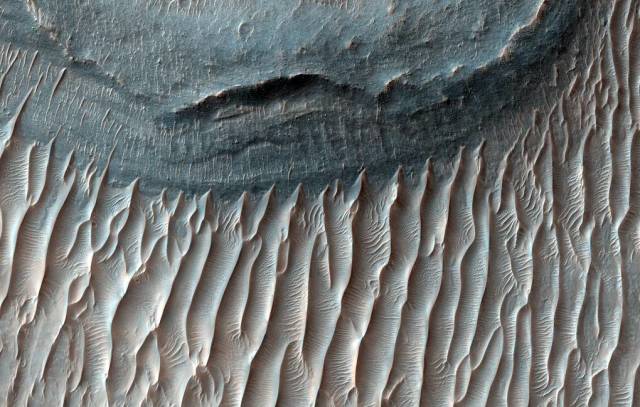According to the theory, this ice should gradually evaporate, but for some reason it does not become less
TASS, December 15. The ExoMars-TGO probe found large reserves of ice in one of the deep canyons located in the center of the Mariner Martian valleys. The results of the study were published by the scientific journal Icarus.
"The TGO probe can search and study the "oases" of Martian water hidden under a multi-meter layer of dust and soil, which in the past we simply could not detect. In particular, the FREND device discovered a site in the canyon system in the Mariner Valleys, 40% of the surface of which is covered with ice deposits," said Igor Mitrofanov, one of the authors of the study, head of the Department of Nuclear Planetology at the Institute of Space Research of the Russian Academy of Sciences.
The Mariner Valleys are a giant system of canyons in the southern hemisphere of Mars. In the early 1970s, it was discovered by the American probe "Mariner-9". Scientists estimate their length at about 4.5 thousand km, and their depth at about 11 km. That is, the Mariner Valley is the largest canyon on all the planets of the Solar System.
For quite a long time, scientists have assumed that there may be a lot of ice hiding in the darkest corners of the Mariner Valleys. However, until recently, it was not possible to find unambiguous traces of their existence. Planetary scientists from Russia and the Netherlands, led by Mitrofanov, coped with this task.
A key role in the discovery was played by the FREND neutron spectrometer installed on board the ExoMars-TGO probe. It can detect traces of water and other hydrogen compounds in the depths of Mars by the way they interact with the flow of cosmic neutrons. A year ago FREND had already discovered several "water oases" on the slopes of volcanoes in the equatorial latitudes of Mars, where ice was supposed not to be.
Mitrofanov and his colleagues analyzed FREND data obtained during a flyby over the territory of the Mariner Valleys in 2018-2021. It turned out that in one of the central areas of these canyons, which planetary scientists call the "Chaos of Kandor", significant reserves of water ice are hidden.
According to astronomers, the proportion of water in the near-surface rocks of the "Chaos of Kandor" is at least 40%. That is, it is there in the form of pure ice, and does not hide inside any minerals. That is, this part of the Mariner Valleys is particularly interesting to study, including during future robotic and manned expeditions to Mars.
Of particular interest to scientists, as Mitrofanov and his colleagues note, is how water ice remains stable in this part of Mars, where its deposits should gradually evaporate and evaporate into space. This speaks either about the unique climatic and geological conditions in the Mariner valleys, or indicates that local water reserves are constantly replenished, the scientists summed up.


